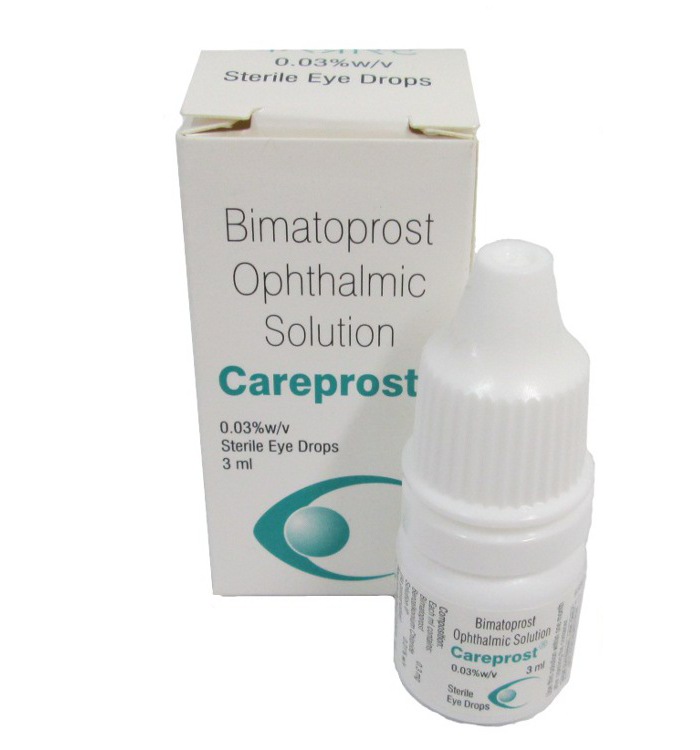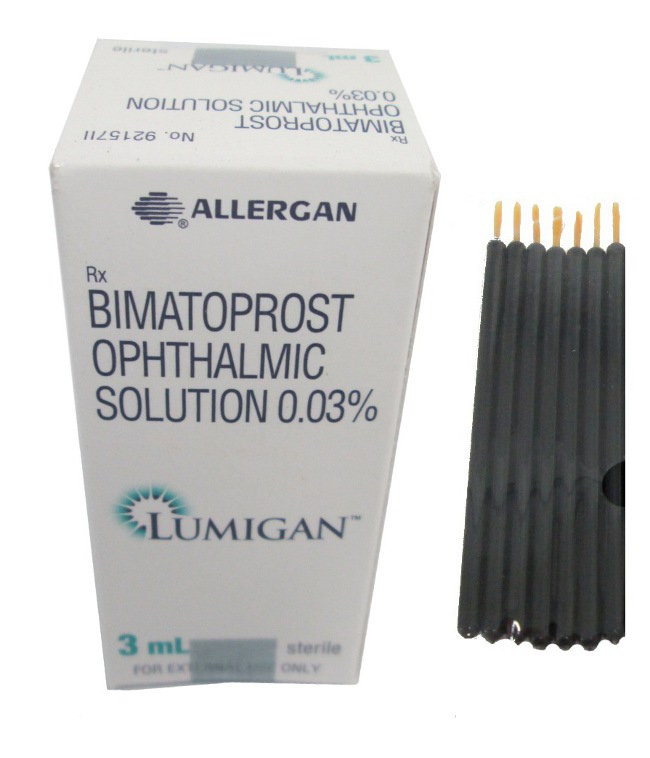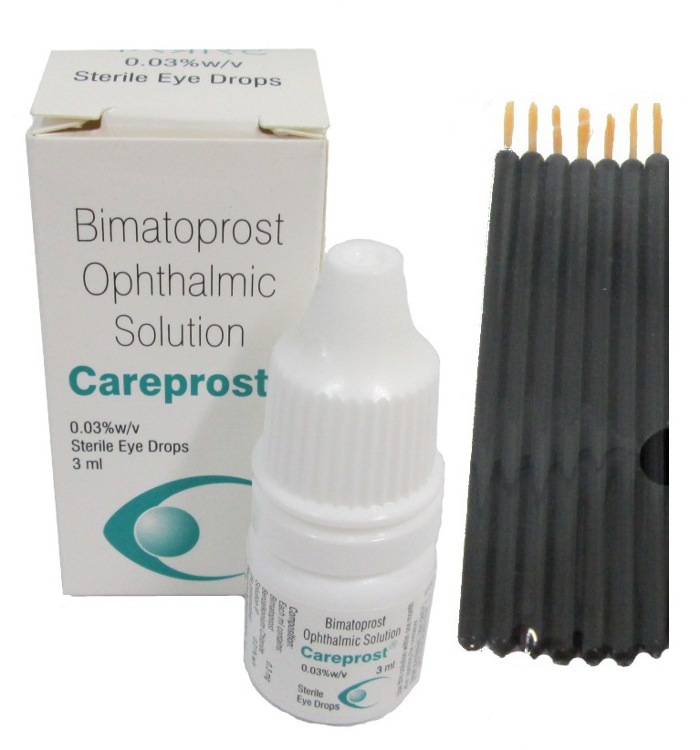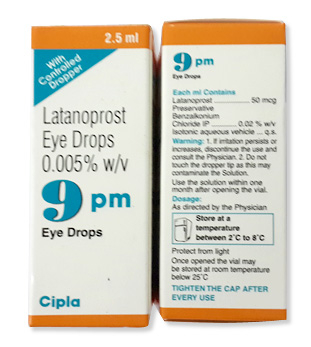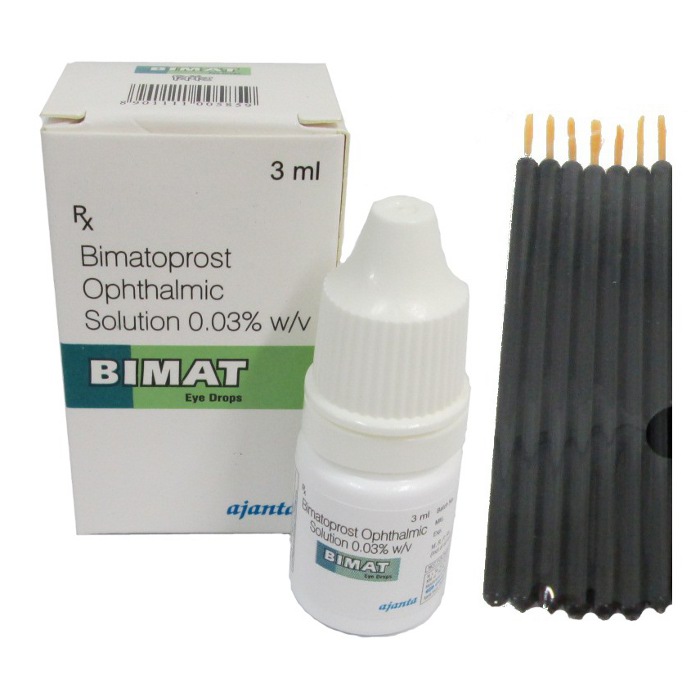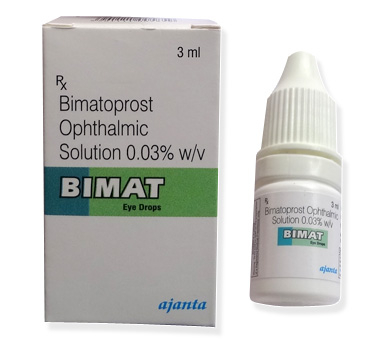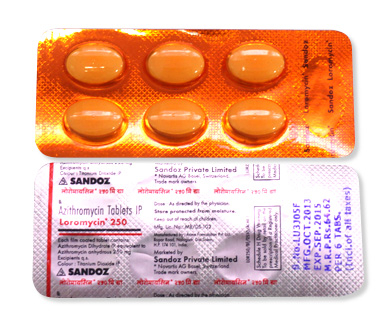Lumigan
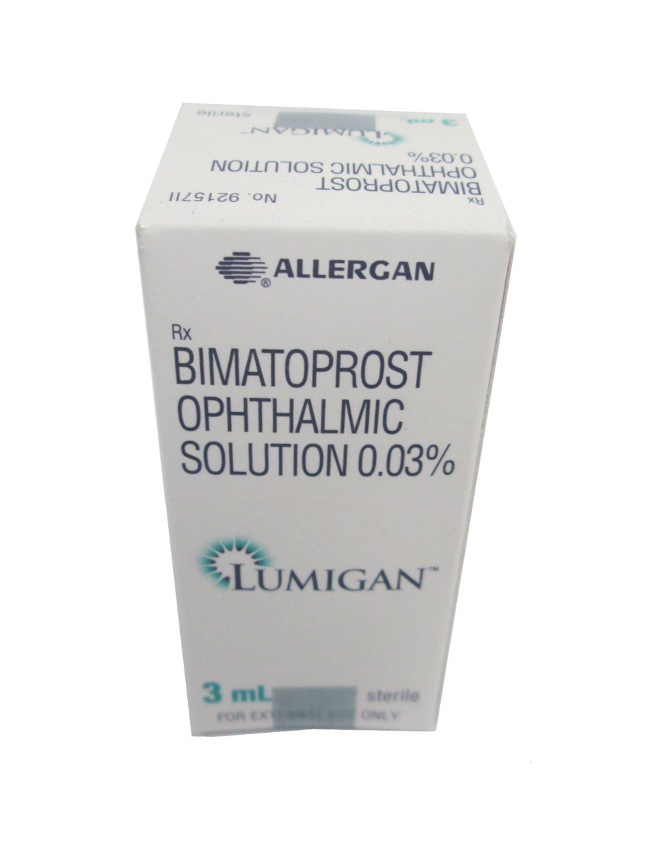
Lumigan
- Lumigan can be purchased at pharmacies with a prescription. Order online for delivery to Romania (ANMDMR-approved), EU, US, and other countries. Prescription required.
- Lumigan (bimatoprost) treats open-angle glaucoma and ocular hypertension by reducing intraocular pressure. It’s a prostaglandin analogue that increases aqueous humor outflow.
- The usual dosage is one drop in the affected eye(s) once daily in the evening. Do not exceed one dose per day.
- Form of administration is ophthalmic solution (0.01% or 0.03% eye drops) in dropper bottles (2.5mL, 3mL, or 5mL).
- The onset of action begins approximately 4 hours after administration, with pressure reduction measurable within this timeframe.
- The duration of action is up to 24 hours, requiring once-daily dosing for sustained intraocular pressure control.
- No significant alcohol interactions are documented, but consult your doctor regarding consumption as systemic effects are possible.
- The most common side effect is ocular hyperemia (eye redness), occurring in up to 25% of users but usually mild.
- Would you like to try Lumigan for your ocular health? We provide prescription support and reliable delivery.
Basic Lumigan Information
| Category | Details |
|---|---|
| INN (International Nonproprietary Name) | Bimatoprost |
| Brand names available in Australia | Lumigan |
| ATC Code | S01EE03 |
| Forms & dosages | Ophthalmic solution: 0.01%-0.03% strengths in 2.5mL/5mL dropper bottles |
| Manufacturers in Australia | AbbVie (formerly Allergan) |
| Registration status in Australia | Registered with Therapeutic Goods Administration |
| OTC / Rx classification | Schedule 4 (prescription-only) |
Lumigan contains the active ingredient bimatoprost, a prostaglandin analogue developed for eye care. In Australia, it's primarily supplied as preservative-free eye drops in small dropper bottles containing either 2.5mL or 5mL of solution. While branded as Lumigan locally, you might encounter it as Lukigan in CIS countries. As a Schedule 4 medicine, you'll always need a current prescription from your doctor to purchase it from Australian pharmacies. The medication falls under the ATC classification S01EE03. With its formulation designed specifically for ocular use, it comes with a controlled dropper tip for precise dosage application directly to the eye surface. For up-to-date regulatory details about its approval status, you can check the Australian Register of Therapeutic Goods.
Pharmacology and Mechanism of Lumigan
The effectiveness of glaucoma treatments like Lumigan comes from their targeted action within the eye's drainage system. Lumigan functions as a prostaglandin analogue, specifically mimicking natural substances that help regulate fluid movement. Its primary method of reducing elevated eye pressure involves increasing uveoscleral outflow – this means it improves drainage through alternative pathways in the eye's middle layer. This action helps balance the production and drainage of aqueous humor, the fluid inside your eye.
When applied properly, Lumigan eye drops begin working within approximately four hours. The maximum pressure-lowering effect typically occurs between eight to twelve hours after administration. The active ingredient bimatoprost undergoes breakdown primarily in your eye tissues through enzyme hydrolysis, which means minimal amounts enter your bloodstream. This locally targeted metabolism contributes to Lumigan's favorable safety profile as systemic absorption remains low, resulting in fewer body-wide side effects. Ongoing research continues to explore how these prostaglandin mechanisms maintain consistent intraocular pressure reduction with nightly use.
Clinical Applications and Off-Label Use Considerations
In Australia, the Therapeutic Goods Administration approves Lumigan specifically for managing open-angle glaucoma and ocular hypertension – conditions involving elevated pressure inside the eye that can damage the optic nerve. Clinical evidence supports its use as a standalone treatment or alongside other intraocular pressure medications when required. Your treating ophthalmologist might also discuss potential off-label uses of bimatoprost during consultations; the most commonly observed being eyelash enhancement which occurs as a cosmetic side effect.
The TGA hasn't officially approved Lumigan specifically for improving eyelash growth. People experiencing thin or inadequate lashes due to medical conditions might sometimes receive alternative therapeutic options. Lumigan carries important restrictions for specific patient groups. It should be avoided completely during active eye infections like bacterial conjunctivitis and various forms of ocular inflammation. The safety profile hasn't been established for individuals under sixteen years of age. These medical contraindications reinforce why professional oversight remains essential before starting or modifying eye drop regimens.
Dosage Schedules and Special Population Considerations
Consistent nightly application forms the cornerstone of Lumigan effectiveness. The standard Lumigan dosage involves administering one drop directly into the affected eye each evening. Using a mirror when applying eye drops helps ensure accuracy while minimizing solution waste.
- Timing tip: Associate dosing with an evening routine to help avoid missing applications
- Missed doses: If you forget a daily dose, apply it when you remember unless the next dose is scheduled soon
- Critical reminder: Do not apply two drops consecutively as this may cause paradoxical increases in eye pressure
Considerations for specific populations:
People with kidney or liver impairment typically don't require bimatoprost dosage adjustments, though more frequent monitoring might be scheduled during prescribing. Older glaucoma patients generally tolerate Lumigan therapy, without needing age-based modifications to their medication protocol. Children and adolescents should not use this glaucoma treatment until controlled clinical trials confirm its safety in these demographic groups. Unlike other medications where timing schedules change regularly, Lumigan therapy generally remains consistent long-term until your eye specialist recommends otherwise.
Contraindications and Precautions for Lumigan Use
Lumigan isn't suitable for everyone. Absolute restrictions include confirmed hypersensitivity to bimatoprost or any solution ingredients, alongside active eye inflammation like uveitis. Relative precautions apply to patients with tear-producing structures in our eyes may lead to fluid buildup requiring monitoring. Asthmatics and those with severe COPD require cautious use due to rare respiratory exacerbation reports. Globally available formats like Lumigan eye drops have Australia-specific requirements that must be met. During pregnancy, Lumigan falls into Category C status - animal studies show risks to foetuses, making it unacceptable unless benefits outweigh potential harms. Breastfeeding considerations warrant paediatric consultation before use.
Side Effects Profile of Lumigan
| Frequency | Side Effect | Management Tips |
|---|---|---|
| Common (≥10%) | Reddened eyes, itching, temporary blurred vision | Apply cool compress; usually resolves within weeks |
| Less Common | Darkening of iris/periocular skin, eyelash thickening | Permanent in 1 in 4 users; discuss cosmetic impact |
| Rare (<1%) | Corneal swelling, ocular infection, breathing difficulties | Immediately discontinue and contact healthcare provider |
Most adverse reactions diminish over several weeks. Permanent iris darkening occurs gradually but may affect only the treated eye. Discontinuation becomes vital if corneal oedema develops.
Patient Experiences and Real-World Reviews
Users consistently report two distinct patterns when discussing their treatment journeys online. Many express satisfaction with Lumigan's intraocular pressure control efficacy. Feedback highlights consistent measurements and reduced dependency on other medication types for glaucoma management. Unexpected benefits feature prominently - perceived eyelash growth appears commonly. However, persistent concerns occupy discussions too:
- Unmanageable ocular redness lasting beyond initial weeks
- Stinging sensations during application affecting comfort levels
- Adjusting to administering medication consistently at night
Practical adherence strategies patients share collectively include setting evening medication alarms and establishing application routines post-dinner. Individuals similarly stress consulting primary pharmacies first for irritation management rather than self-adjusting dosages.
Australian Market Snapshot and Accessibility
Pricing for Lumigan remains consistent horizontally. Out-of-pocket expenditure falls typically between sixty-five to eighty-five Australian dollars per three-millilitre dropper bottle. Larger packaging increments such as five-millilitre formats increase accordingly. Distribution channels spread widely across:
- Major pharmacy chains like Chemist Warehouse and Amcal
- Independent community pharmacies throughout the states
- Hospital outpatient dispensaries for coordinating care conditions
Demand stays predictable without emerging supply hurdles. Prescription-only status persists unchanged though generic availability provides lower cost alternatives. Availability throughout Australia remains reliable with consistent turnaround following presentation.
Clinical Alternatives Comparison
| Drug Name (INN) | Effectiveness Comparison | Price Range (AUD) | Key Differences |
|---|---|---|---|
| Latanoprost | Comparable pressure reduction | 50-65 | Lower risk of redness; favourable initial option |
| Travoprost | Marginally improved efficacy metrics | 70-90 | Cardiovascular side effect considerations |
| Generic Bimatoprost | Identical active ingredient profile | 45-60 | Cost-saving potential with similar safety |
Therapeutic choice involves balancing lowering intraocular pressure needs, adverse effect tolerance and managing chronic medication expenses. Ophthalmologists may recommend alternatives if Lumigan starts losing effectiveness against advancing glaucoma. Regular monitoring informs suitability and necessary formulation adjustments accordingly.
Research Updates and Generic Availability
Recent clinical evidence continues to refine our understanding of bimatoprost. A 2023 Australian-led randomised controlled trial demonstrated comparable efficacy between Lumigan 0.01% and the older 0.03% formulation for intraocular pressure reduction. Crucially, the lower concentration formulation showed significantly fewer reports of conjunctival hyperaemia and eyelash changes while maintaining therapeutic benefits.
The patent landscape shifted significantly when Allergan's exclusivity expired after 2020. This triggered rapid entry of generic bimatoprost alternatives across Australia's Pharmaceutical Benefits Scheme. Multiple generic versions now appear in pharmacies under names like Bioprost and Careprost, offering price reductions of 20-45% compared to branded Lumigan without compromising active pharmaceutical ingredient standards.
Current phase II trials focus on novel delivery systems including nanogel formulations. These experimental sustained-release technologies aim to decrease application frequency while improving corneal penetration rates. Meanwhile, therapeutic goods administration regulators maintain strict bioequivalence testing requirements ensuring generic products meet identical quality thresholds as reference brands.
Frequently Asked Questions for Australian Consumers
Is Lumigan used for eyelash growth? Though some online influencers promote it cosmetically, TGA has never approved Lumigan for eyelash enhancement. Using glaucoma medication for this off-label purpose risks serious ocular irritation and permanent iris darkening. A separate bimatoprost 0.03% formulation exists specifically for hypotrichosis under strict prescription controls.
Does Medicare cover Lumigan costs? Pharmaceutical Benefits Scheme subsidy applies only for Department of Health-authorised glaucoma or ocular hypertension prescriptions. Eligible patients pay maximum PBS co-payment ($31.60 in 2024) when dispensing community pharmacists process valid authority scripts. Always confirm current eligibility through Services Australia before dispensing.
Can I drive after using bimatoprost? Approximately 5-10% of users experience transient blurred vision post-application. Avoid driving or operating machinery until visual clarity fully returns, typically within 15 minutes. Schedule evening administration to minimise daytime interference and always report persistent visual disturbances to your ophthalmologist.
Safe Application Protocols
Correct usage technique prevents contamination and maintains therapeutic efficacy:
- Wash hands thoroughly with soap
- Tilt head back and gently pull the lower eyelid downward
- Instill one drop into the conjunctival pocket without touching the eye surface
- Close eyes gently for two minutes without blinking forcefully
- Wait 15 minutes before reinserting contact lenses
Avoid storage extremes between medicinal applications. Keep sealed bottles between 2°C-25°C (refrigeration optional) without freezing. Protect from direct light exposure and discard opened containers after 6 weeks due to preservative degradation. Never share eye droppers between individuals as microbial contamination risks corneal infection.
Common patient mistakes include applying extra drops after missed doses (interrupts medication rhythm) or allowing dropper tips to contact eye surfaces (introduces bacteria). Both errors paradoxically increase intraocular pressure while raising contamination risks. Travellers should carry prescriptions and temperature-controlled containers to comply with Australian border protection medication regulations.

